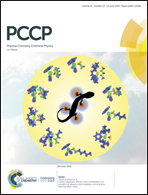Exchange-biased hybrid γ-Fe2O3/NiO core–shell nanostructures: three-step synthesis, microstructure, and magnetic properties†
Abstract
A two-step solvothermal method combining a calcination process was conducted to synthesize γ-Fe2O3/NiO core–shell nanostructures with controlled microstructure. The formation mechanism of this binary system has been discussed, and the influence of microstructures on magnetic properties has been analyzed in detail. Microstructural characterizations reveal that the NiO shells consisted of many irregular nanosheets with disordered orientations and monocrystalline structures, packed on the surface of the γ-Fe2O3 microspheres. Both the grain size and NiO content of nanostructures increase with the increasing calcination temperature from 300 °C to 400 °C, accompanied by an enhancement of the compactness of NiO shells. Magnetic studies indicate that their magnetic properties are determined by four factors: the size effect, NiO phase content, interface microstructure, i.e. contact mode, area, roughness and compactness, and FM–AFM (where FM and AFM denote the ferromagnetic γ-Fe2O3 and the antiferromagnetic NiO components, respectively) coupling effect. At 5 K, the γ-Fe2O3/NiO core–shell nanostructures display certain exchange bias (HE = 60 Oe) and enhanced coercivity (HC = 213 Oe).



 Please wait while we load your content...
Please wait while we load your content...